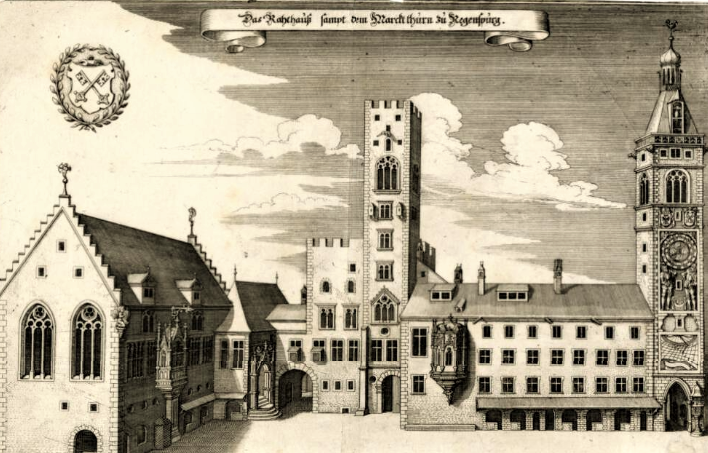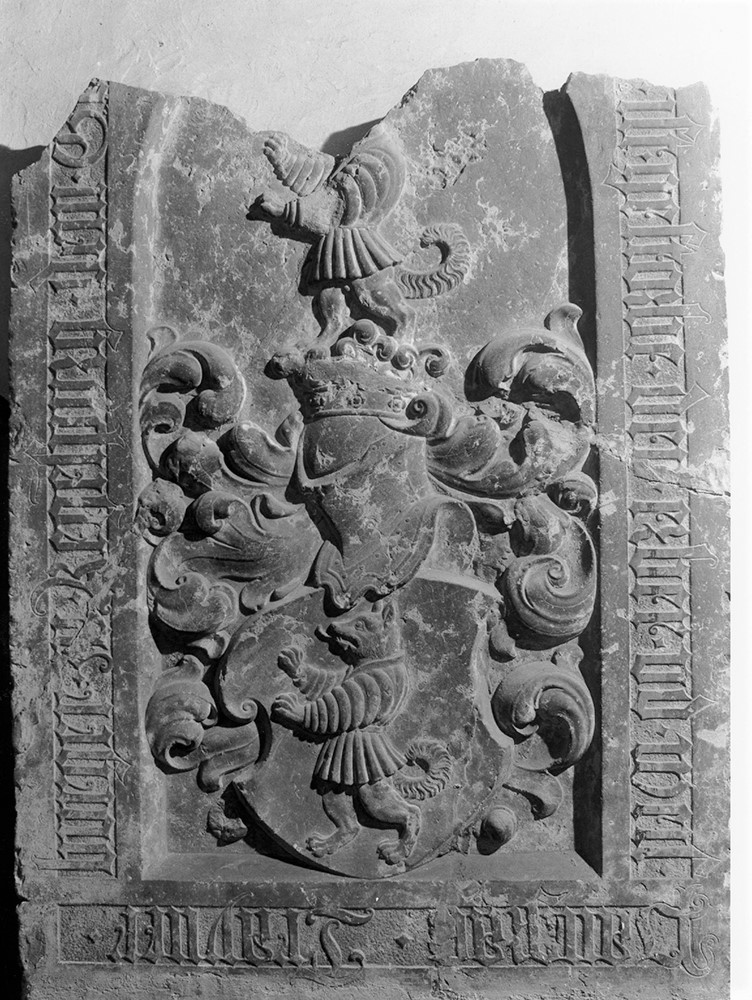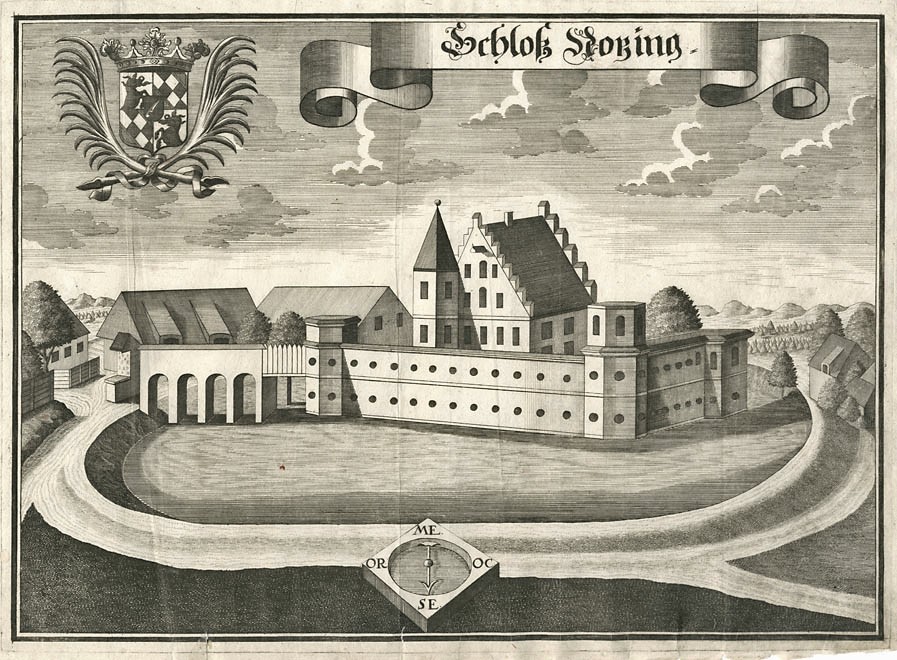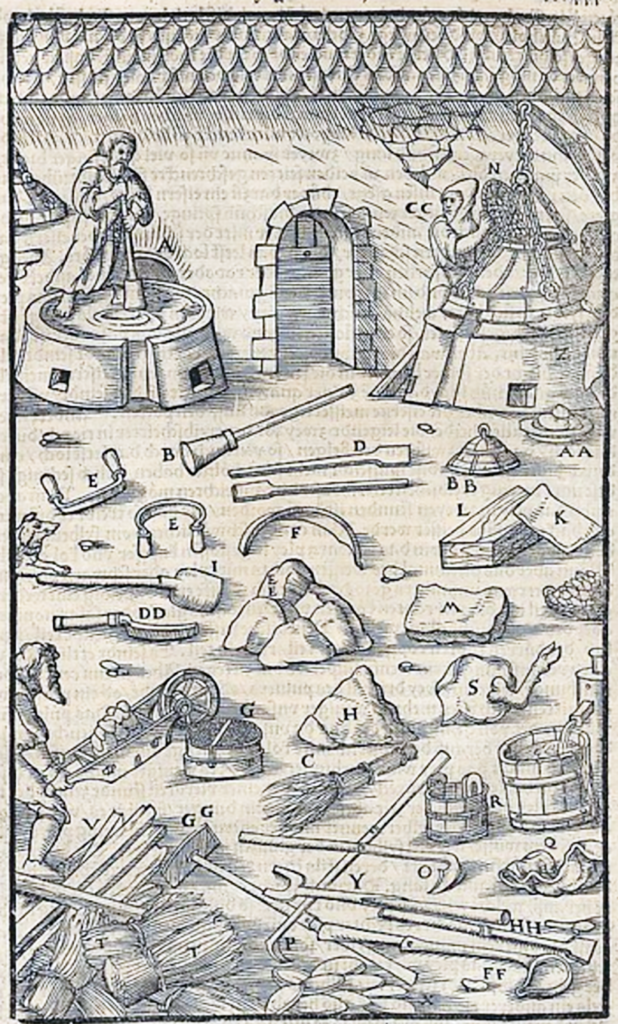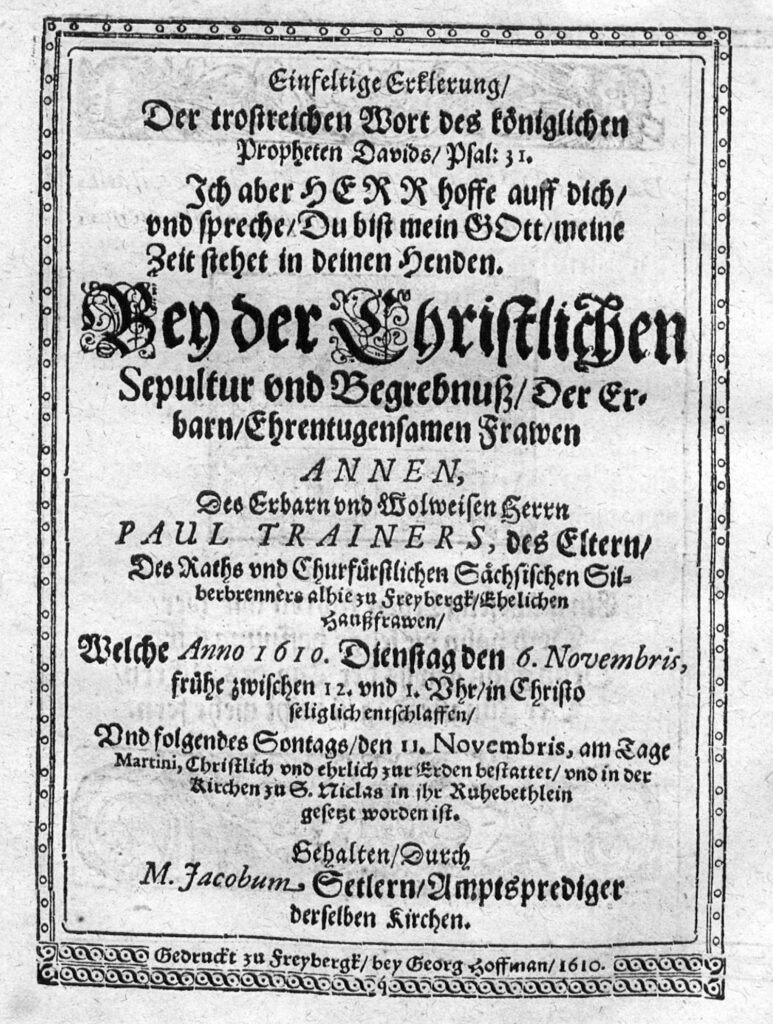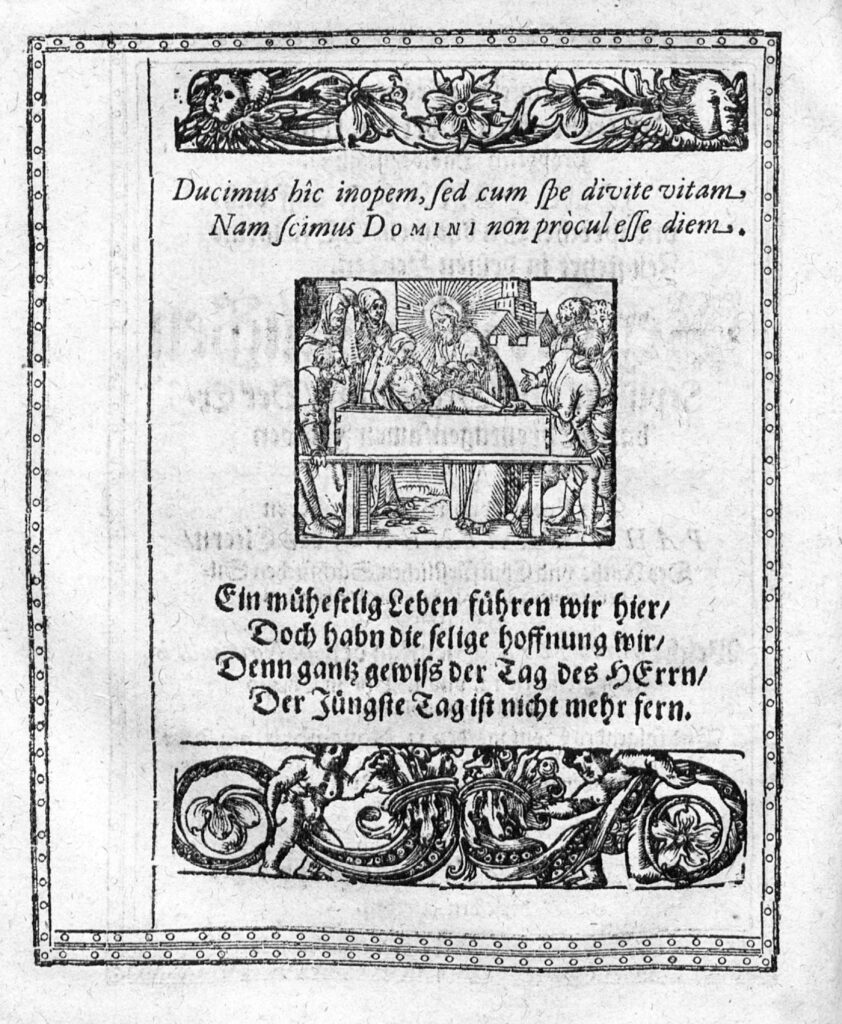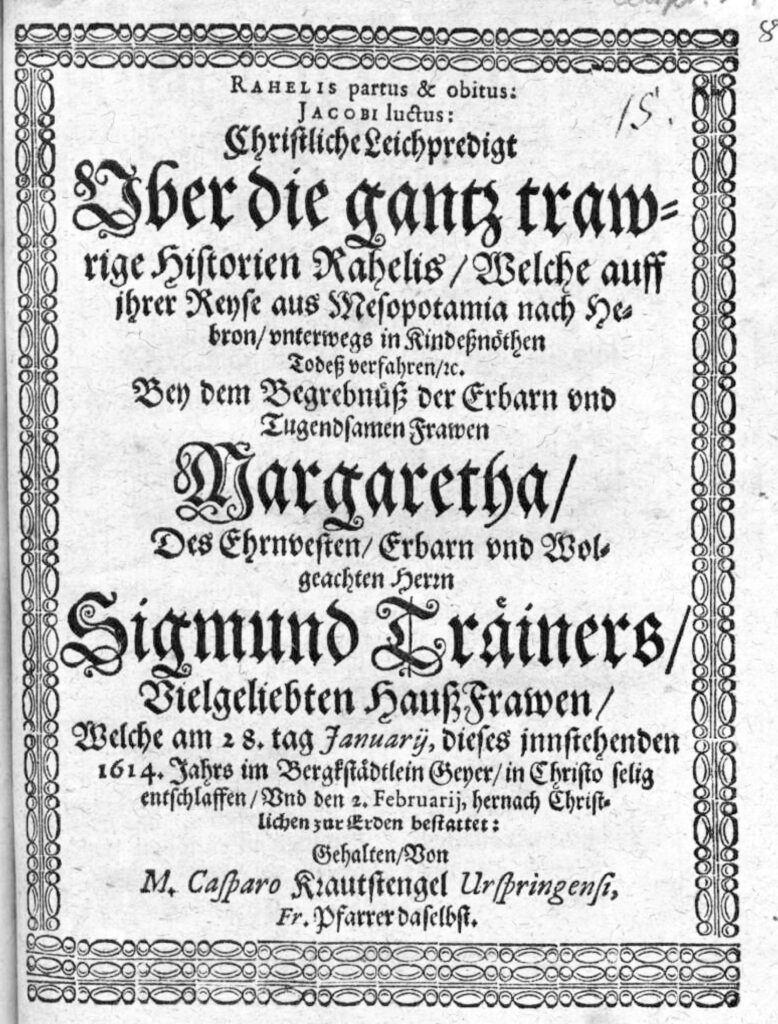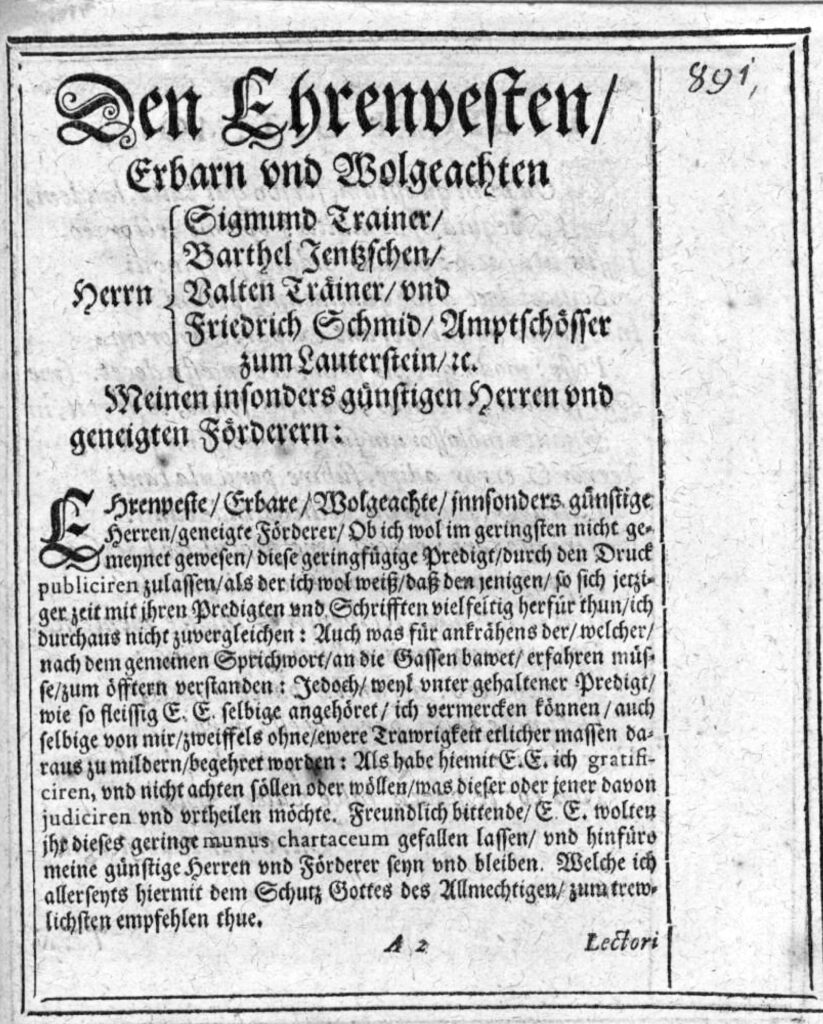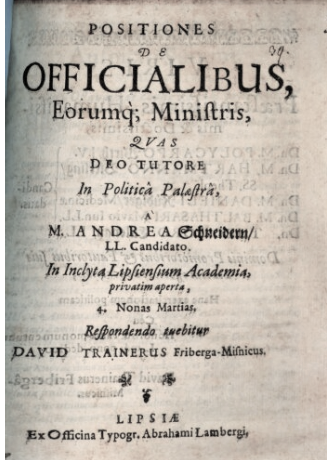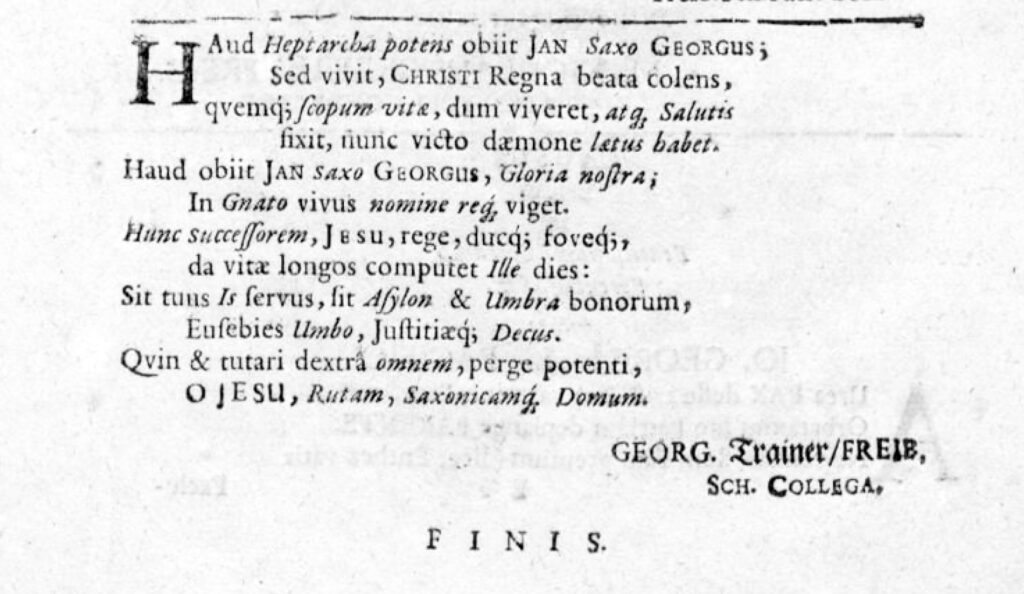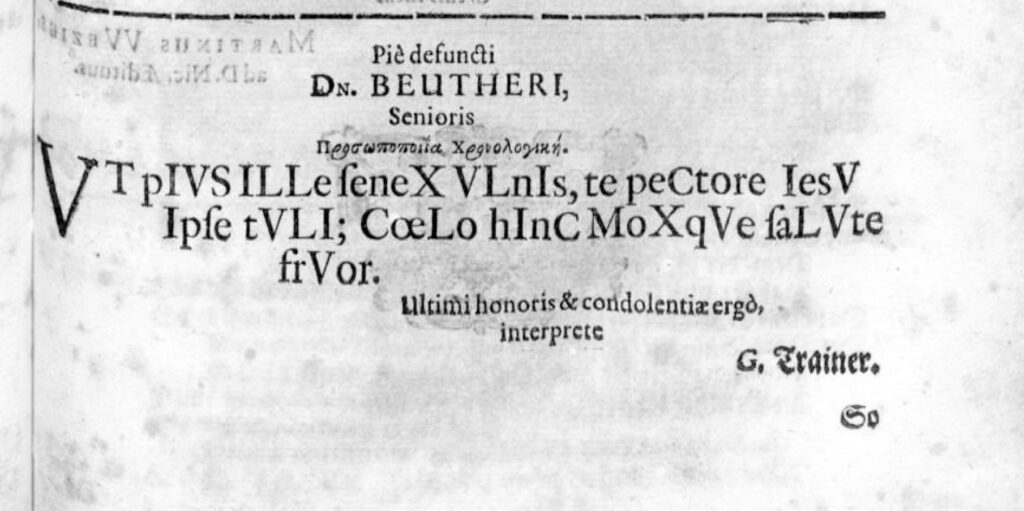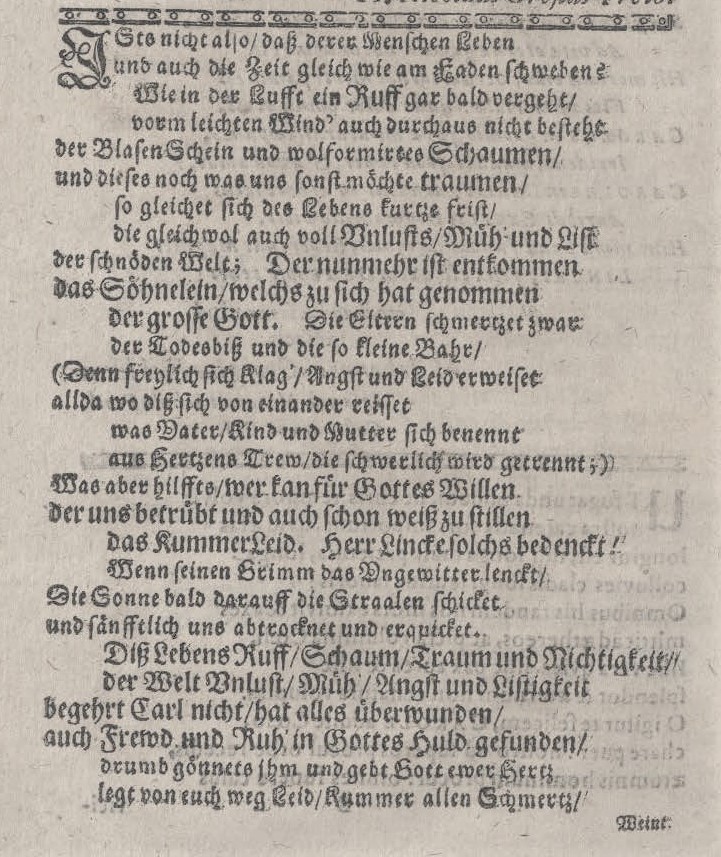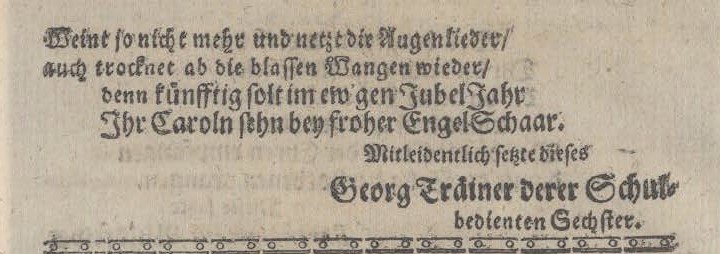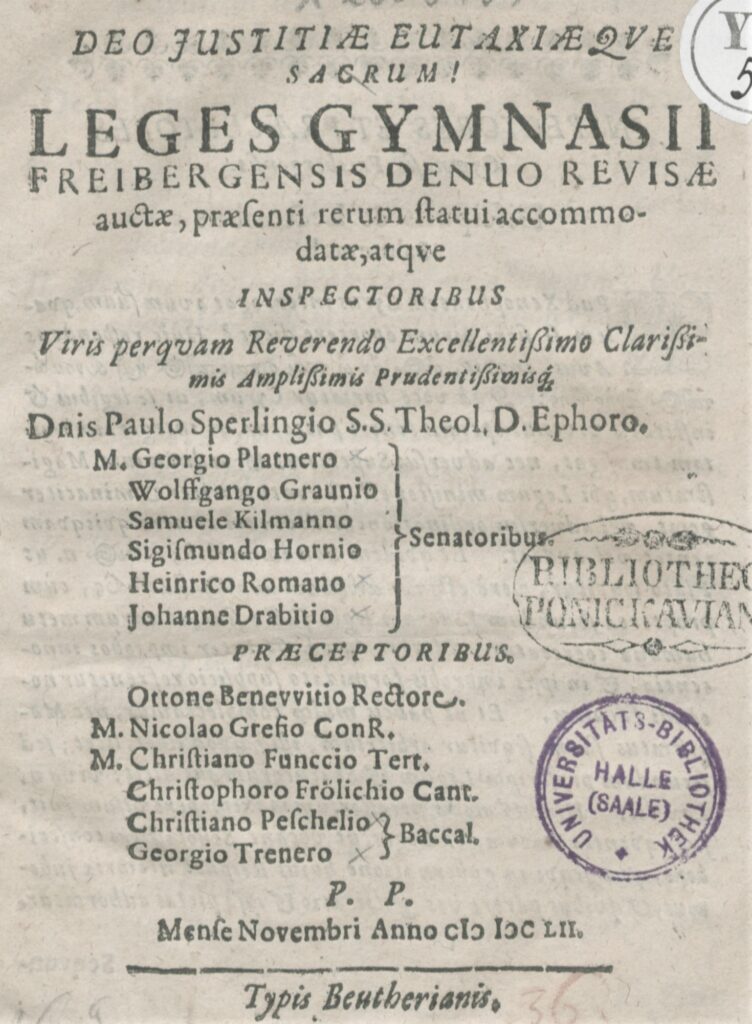Otto Erwolf, called “the Trainer”(ca. 1240 – 1301) == Lucia von Alburg >> Wolfhard d. Ält. Erwolf gen. == Salome Sarching >> Wolfhart the younger Trainer (1320 – ?) = Margarethe ? Zant ? >> Ulrich Trainer (1355 – 1412) = Anna Nothafft Von Hetzkoven (1365? – 1426) >> Erasmus Trainer (1400 – 1481) == Ursula Probst (1409 – 1448) >> Hans Trainer (1430 – 1507) == Walpurgis Portner (ca. 1435 – 1480/85) >> Paul Trainer (1472 – 1552) == Magdalena Alnpeck >> Catharine Trainer (1516 – 1583) == Wolfgang Hilliger (1511 – 1576) >> Oswald Hilliger (1550 – 1610) == Ann Schönleben (ca. 1562 – 1646) >> Oswald Hilliger (1583 – 1619) == Margaretha Horn (1594 – 1622) >> Barbara Hilliger (1618 – 1663) = 1645 = Burchard Berlich (1603 – 1670) >> Susannah Berlich == George Adam Struve >> >> >> >> The Three Loeck Sisters
The patrician family of Trainer belonged to the Bavarian landed gentry and has been documented in Regensburg since approximately 1256. A separate web page containing data on the families of the women who married into the Trainer family such as: Zant, Probst, and Portner and that has the title “The Antecedent Families … ” can be viewed HERE.
Most of the information on this page is based on the four-volume edition: “Das Geschlecht Trainer: von 1250 bis zur Gegenwart” (1964 – 1966) by Wolfhart Trainer. However, recent studies have suggested that this source may not be entirely reliable as its author tended to depend on older family history descriptions which were often based on memories and which have subsequently been found to be flawed. Nonetheless we believe that, although flawed, much of the information is reliable enough to be included here.
Unless otherwise stated, all the events described on this page (births, marriages, deaths, etc.) occurred in and around Regensburg.
TRAINER GENEALOGY: The Earliest:
1. Otto Erwolf, called “the Trainer,” was born about 1240/50, died 1301 and buried in the chapter house at Byburg. Because the Count of Abensberg was in his debt, Otto occupied under legal trust the Count’s castle at Train. Accordingly, in about 1291, Otto came to be known as “The Trainer” which is the derivation of the family surname. He was married in about 1276 to Lucia von Alburg. She was the daughter Simon von Alburg / Ahlburg and Catharina Pröckhendorffer / Praeckendorff.
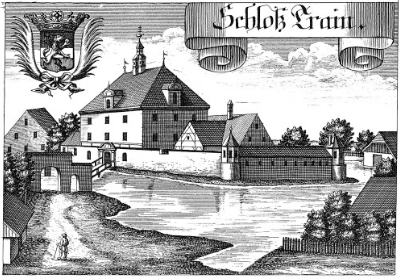
2. Wolfhard d. Ält. Erwolf gen. Trainer (the Elder, called Trainer), born 1280/90. He married twice: first in 1320 to Mechthildis Sallerin von Meilhoven and second in 1330 to Salome von Sarching (Oberpfälzischer Adel). From this second marriage came:
3. Wolfhard, the Younger, died 1378. He traded mostly in wine. He is said to have married Margaret Zant but this has been disputed.
4. Ulrich, born ca. 1355, died 1412, buried in the hereditary burial in the cathedral cemetery with his parents. Ulrich married at Regensburg between 1397 and 1400 Anna Nothaft von Hatzkoven, also called Nothafftin von Hötzkouen (Hetzkoven, Heitzenhofen), as well as Nothafft zu Wernberg. Anna was born around 1365 / 66, and she died after 1426. Anna was first married to Elrich Muracher zu Flügelberg. Because the Nothafft were a sprawling and well-connected family a separate page devoted to that family can be found here.
Ulrich Trainer is said to have expanded his father’s long-distance trade to the east with household goods, especially wine and cloth, but also as a broker in the iron trade. During the armament of the city of Regensburg in the Swabian War of Cities, he was part of Captain Hans Ingolstetter’s squadron. His economic situation must have been quite good, for example he put up 12 armed men at the magnificent jousting tournament of princes in 1408. For many years he served his native city: from 1392 as a councilor of the outer governing city council, and from 1394 as a member of the inner governing city council.
He was repeatedly an assessor of the Hansrat and appears in numerous existing documents as a seal witness (notary), defender, and guarantor.
He was also a confidant of Duke Ludwig VII of Bavaria-Ingolstadt, to whom he wrote diplomatically in 1406 in a handwritten letter that still exists, at Ludwig’s request, on the mood in Regensburg.
An addendum to his will dated January 5, 1412 gives an idea of his good financial situation.
As noted, because his wife’s von Nothaft family was of the nobility and has an extensive well recorded history we devote a page of its own to that family.
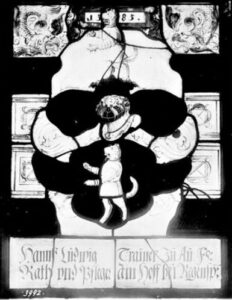
Ulrich and Anna had a son:
5. ERASMUS (1400 – 1481), who was often on the Regensburg city council between 1431 and 1480. He was Hansgraf in 1441 and 1445, city treasurer 1456, 1459, 1464, 1466 and 1469.
He was married three times:
I. URSULA (Probst) Trainer, born around 1410, the daughter of Martin Probst I auf Tunau the Younger (born around 1370, died 1453/57) and Anna (Hirss) Probst. Anna was a daughter of Jörg im Hirss and Anna, née Sitauer. Anna Sitauer was the daughter of Thomas Sitauer and his wife Anna, née Ingolstetter. She died in 1448.
Two sons, HANS and Veit, came from this marriage
And two daughters: Afra and Ursula. This Ursula (1439 / 1440) deceased on 2 Nov 1480 and buried on 11 Nov 1480. She married Wilhelm Francke / Frank von Sulzbach (1440 -1516). He was lord of the land and hammer at Ettmannsdorf (district Schwandorf / Opf.), who acquired citizenship in Regensburg. They had a daughter Ursula Franck von Sulzbach (1470-1535) who married Linhard / Lindhard Portner von Theuern.
II. N N Gumprecht daughter of Ulrich Gumprecht.
III. Married in about 1455 to Anna Grasknecht, born about1420, the daughter of Hans Grasknecht, Bürger at Straubing.
Like his father, Erasmus Trainer was a wealthy long-distance trader, who lent money at interest and owned a large number of houses in the city, as well as estates and vineyards in the near and far vicinity, the proceeds of which he managed. His wealth also brought responsibilities. For example, at the Reichstag (Town Hall) in Regensburg in 1454, Erasmus had to accommodate 100 horses and over 100 men, as well as the Bishop of Trier and a large entourage.
[This meeting was provoked by The Fall of Constantinople, capital of the Byzantine Empire, to the Ottoman Turks in May 1453. Emperor Friedrich III and Pope Nicolas V, convened a conference of the European rulers and German princes in the city of Regensburg in May 1454 to decide what to do, but the only result of the diet was to agree on war in principle and to call for another diet to further discuss the matter.]
Erasmus was also very active in the city administration. He is documented as being a councilor 22 times from 1431 until his death, as a steward 6 times, as a sergeant 3 times, as the Ostenwacht twice, and as a Stauffher (nurse of Donaustauff) 5 times.
Very often he also administered the highest civil office of chamberlain and as such was mayor, since there had been no official office of mayor of Regensburg since 1429. He was also hansgraf twice, to whom the 12 Hansherren were subordinate. The reputation that he enjoyed in these offices allows him to appear in many surviving documents as a sealer, Zewuge, guarantor, business owner (executor) and tweidiger (defender). The council also liked to use him as ambassador from the free imperial city to the princely courts.
Around 1475, the Trainer family in Regensburg, consisting of Erasmus, his wealthy childless brother Ulrich, and his sons Hans and Veit, was at the height of its reputation and wealth. Through his mother, née von Nothafft, Erasmus was related to the Upper Palatinate-Bavarian landed nobility, and through his marriages he was related to the powerful patrician families of the city – Probst and Gumprecht – and through the wives of his sons Portner and Ingolstetter.
6. HANS Trainer, born around 1430, and died after 1507, buried at St. Emmeran. He was married around 1470 to Walpurgis Portner. She was born in 1435 and died in 1480/85, and was also buried at St. Emmeran. She was the daughter of Peter and Barbara (Sterner) Portner. Walpurgis was also the sister of the well-known mayor and city treasurer Linhard / Leonhard Portner, whose son Linhard married Hans Trainer’s niece Ursula Frank in 1451.
As a long-distance trader, he is less important than his father, Erasmus, which is probably more due to a general decline in Regensburg trade. The administration and exploitation of his own properties, houses and vineyards was probably his main economic activity. All the more he devoted himself to his municipal and other offices.
As Bridge Master of the famous “stone bridge” over the Danube from 1477 to 1492, he was in charge of the customs officers, the bridge, its gradients, interest, and taxes, for which he had to render an account to the council.
Furthermore, for many years he was the caretaker of the infirmary St. Lazarus on the Steingrube near Regensburg and claimed this care hereditarily as a descendant of the Zant family, through which this infirmary (for special ailments) had once been founded. Soon after his father’s death in 1481, he was also elected to the inner council and is documented as a councilor at least in the years 1483, 1485, 1486 and 1492. He was chamberlain several times and as such mayor (duumvir).
The fate of his life is closely linked to the battle for Regensburg in the years 1486 to 1492. As a result of its financial distress and the deceptive promises of Duke Albrecht of Wittelsbach the free and proud city submitted to the Duke in 1486. Instead of an improvement, however, the situation deteriorated even more due to the ban imposed by the Kaiser and the strangulation of the trade routes. Nevertheless, the Emperor was only able to bring Regensburg back to the Empire in 1492 by levying troops and massive threats.
During this time of submission, the councilman Hans Trainer, who was also Hansgraf in 1486/87, along with his brother Veit, a probation judge and councilman, and two others from the council regularly reported to the gentlemen in Munich, who debated the situation in Regensburg and who wanted to be kept informed every month.
When imperial commissioners were installed after the liberation in 1492 and a new council was elected, the old councilors were arrested in search of those responsible for the subjugation, including old Leonhard Portner, Hans Trainer’s brother-in-law. The two Trainers (Hans and Veit) and Wilhelm Frank / Francke (their brother-in-law who had married their sister Ursula) were also supposed to turn up in front of the commissioners; but they had all fled the city because they had foreseen what might happen to them.
Hans took his family with him to his estate near Straubing, Veit turned up shortly after his flight in Donaustauf, where he appears in numerous documents; later as a judge and banker until his death in 1495, and Wilhelm Frank probably fled to his hammer mill in Harynow. So, they did not appear before the tribunal although they had been ordered to appear three times, both verbally and in writing. The behavior of the three men was proper, because the imprisoned councilors were treated extremely shamefully, regardless of guilt, innocence, age, or previous merits, thrown into the towers and tortured until finally, after nine months of shameful imprisonment, they were released on bail of 25,000 Gulden.
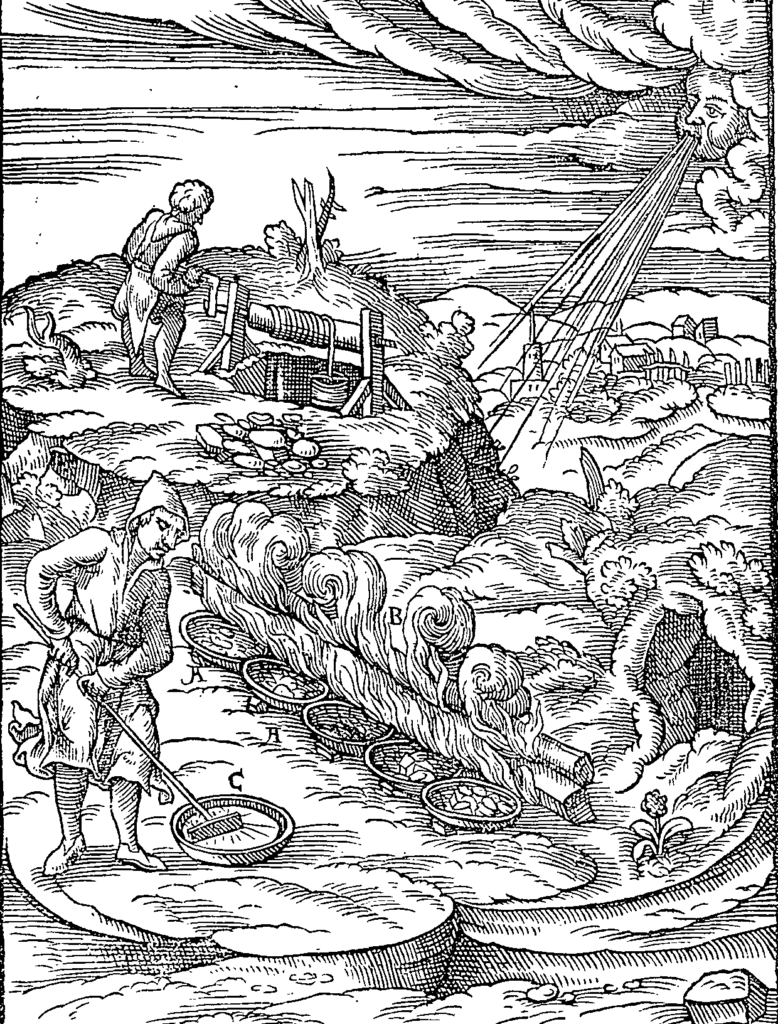
However, it was not until January 1495 that the emperor fully rehabilitated them, returning as the guarantee. After all Regensburg’s attempts to come to an agreement with Trainer had failed, the city sued him in 1496 (!) before the Imperial Chamber Court, which had been newly founded a year earlier, with the aim of confiscating his entire property. His fortune was considerable, as he not only owned 3 town houses in Regensburg but also extensive properties and vineyards in the area. However, the emperor personally intervened in the process in favor of Hans Trainer and so a favorable settlement was reached for him, in which he essentially only had to hand over the care of St. Lazarus to the city.
On May 7, 1505, Hans’ two nephews, Wolf and Achaz, sons of his brother Veit, were elevated by the Emperor to the hereditary nobility from Augsburg. This intercession in the trial and the ennoblement of the whole family are proof of Emperor Maximilian’s conviction that the Trainers had always remained true to the imperial city idea and their apparent collaboration with the duke only had the purpose of saving their native city.
The real culprit in the catastrophe, from which Regensburg was never to recover, was the knight Hans von Fuchssteiner von Fuchsstein or zu Glaubenstorf, who was mayor of Regensburg before the subjugation in 1487 and 1491 and had retired in good time. Later, a reconciliation seems to have taken place between Hans Trainer and his home town, to which he returned, but without playing a role in public life again.
Hans and Walpulgis / Walburga (Portner) Trainer had 6 sons and 3 daughters. The eldest son PAUL (7 below) was the ancestor of The Three Loeck Sisters, who left Regensburg for the City of Freiberg in Saxony. His sister Maria married a knight von Baumgarten and had many descendants.
Another son was Pankraz, who became a citizen in 1507 and later patron of the St. Barbara Chapel in Regensburg. From him, who had no male descendants, a very beautiful epitaph has been preserved in the cathedral, as shown below:
Pankraz was born between 1473 and 1480 as the fourth son of Hans Trainer and his first wife Walburga Portner. In 1507 he received the citizenship of the city of Regensburg. Pankraz was married to Anna, née Fuchs. From this marriage a daughter Barbara emerged. Like many members of the Trainer family, Pankraz was also active in long-distance trade, especially with Italy. In the 1480s he stayed in Padua to learn about bookkeeping and commerce. In the first third of the 16th century, Pankraz Trainer was the patron of the St. Barbara Chapel in today’s Kalmünzer-Gasse, formerly Weintinger-Gasse. The old hospice house next to the Laurentius chapel was also bequeathed to Pankraz in 1503 by Hans Trainer. In 1532 he made his will disposing of his property; three years later his wife is described as a widow when she draws up her will.
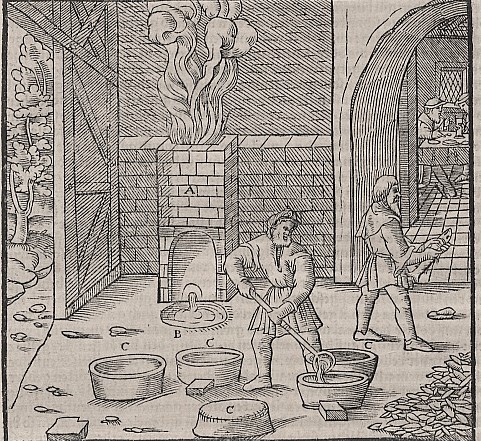
The fifth son of Hans Trainer was Johann, Magister, canon and beneficiary of the old chapel in Regensburg.
The youngest son, Erasmus, was 1543/57 probate of the Augustinian monastery at Herrenchiemsee, but died in 1557 ” … in knowledge of Jesus Christ outside the monastery and the abbey, so he surrendered and left.” a sign that he had given up the old belief (Roman Catholicism).
The three daughters of Hans and Walpurgis (Portner) Trainer were:
A. Ursula married the ducal Bavarian councilor Hieronymus Schrenk, Herr auf Notzing. No children. (Below Schlos Notzing).
B. Barbara married the councilman Erhard Ankofer in Regensburg
C. Catharina, married the townsman Steffan Naufletzar, whose epitaph hung in the Minorite Church.
7. PAUL, was born in Regensburg on 17th February 1472, and he died at Freiburg on 3rd May 1552. He was the son of Hans and Walpurgis (Portner) Trainer. He was a silver smelter as well as a city councilor at Freiberg. He was the direct ancestor of the Three Loeck Sisters.
dr Wolfhart Trainer writes about him:
“Paul was brought up in Regensburg, but left the city with his father at the age of twenty in 1492, never to see it again. Whether he went to Straubing with his father is not certain. Perhaps he went to his uncle Wilhelm Frank, the Regensburg councilman, who owned a hammer mill in Harynow, or to his cousin Linhard Portner, the hammer mill man at Leidersdorf near Amberg, and perhaps it was there that he received the inspiration and knowledge for his later profession as a Silberbrenner. In any case, he left his native Bavaria before the turn of the century and went to Freiberg in Saxony to mine silver, where Stephan von Alnpeck had moved from Regensburg 50 years earlier, and whose granddaughter Magdalena was to become Paul’s second wife.
At Easter 1500 he already appears in the Freiberg tithe accounts as an Electoral Saxon silver distiller, an office that he held for 52 years until his death. In this activity he was also documented from 1520 to at least 1537. He was also appointed warden, i.e. ore tester who had to determine the content of precious metals in ores and alloys. Until 1544 he also appears as a smelter owner who operated his own smelting works independently.
In 1506 he acquired citizenship in Freiberg and was later also active in many aspects of the city administration. In 1516 he became a judge and in 1519 he joined the council, which he was a member of until his death. In 1522/25 he held the office of Hospitaller, in 1526 he became a city judge and village lord and from 1524/26 he was provost of the Virgin Monastery of Saint Mary Magdalene.
He became a wealthy man in Freiberg. In the tax register of 1545, he is listed as having assets of 1,600 Meissen guilders. In the Weingasse he acquired a stately house (Humboldthaus), and landed property, part of the Turmhof fiefdom and a 30-bushel property from the donor, which remained in the family’s possession until 1634. He had also leased a field from the nunnery near Tuttendorf.
Paul married three times:
a) His first marriage was to Veronica (b. 1474), daughter of Tillman von Gunderrode / Güntherode.
b) After her death in 1511 he married Magdalena Alnpeck, a daughter of the mayor of Freiberg, Georg Alnpeck (1462 – 1523) and Magdalena Mannewitz (1476 – 1510). Magdalena was a direct descendant of Rupertus de Alnpeck, mentioned in documentary evidence dated 1137, found in the Chamhaupten Cloisters. It is from this marriage that the Three Loeck Sisters are descended. [Magdalena’s sister, Anna Alnpeck, married Veronica von Gunderrode’s brother Konrad.]
c) Widowed for the second time at the age of 60, Paul married Catharina Hausmann, daughter of the mint master Nikol Hausmann and widow of the famous doctor and mayor Dr. Ulrich Rühlein von Kalbe, who had died three years before after 17 years of marriage.

by Ulrich Rühlein von Kalbe whose widow married Paul Trainer
Paul Trainer’s tomb in Freiburg, which shows him with his eight sons, seven daughters, and three wives, has the following inscription:
“Earth covered the aged Paul Trainer’s bones, his spirit lives happily in the fields of the blessed. Born he was in the castle, which washes the rain with its waves and carrying on the good raft the Latin name (Ratisbonna). He brought with him wisdom to the number of councilors. He had the silver among themselves, the heated furnace and the seventh in the fire in and made solid. His life ended in his 80th year of life in 1552, went as the April to the end. “
The children of Paul and Magdalena (Alnpeck) Trainer are:
8a. CATHARINA TRAINER was born in 1516 in Freiberg, died 18 March 1584 in Freiberg, aged 68 years, and was buried on 20th March 1584 (Tuesday). She was the daughter of the above Paul and Magdalena (Alnpeck) Trainer. In 1536 she married Wolfgang Hilliger (1511 – 1576) and from this marriage the Three Loeck Sisters are descended (See Hilliger family).
8b. Magdalena married the mountain writer Wolf Hassfort in Freiberg.
8c. Veronika married the tithe and box scribe Urban Jahn in Freiberg.
8d. Dorothee, aged 16, married Wolfgang Hilliger’s father, Martin Hilliger, who was also a bell and artillery foundryman. In her second marriage she then married the mayor of Chemnitz Hans Arnold in 1544. (The Rothmaler family (Catersleben near Quedlinburg) came from this marriage.
8e. Georg Trainer, Born in Freiberg on 22 October 1512, the son of Paul Trainer and Magdalena von Alnpeck and brother of the above Catharina. He married Anna Meissner (? – 1588). He was a silver refiner and Mayor of Freiberg. After the death of his father Paul in 1522, Georg Trainer took over his position as electoral Saxon silver distiller and ran it for 30 years until his death.
He also followed his father in 1553 when it was necessary to be a special representative, when King Frederick II of Denmark and the Saxon court visited Freiberg in 1557. For the occasion one dined at an especially long table in the town hall. Georg was a councilor in 1554 and 1555 as well as head of the poor box, then for 5 years he was head of “spiritual income”. He also took over the office of Principal of Freiberg’s gymnasium (praefectus scholae) ” … since he was an author and Maecenas, a lover of learned people, and a good school friend.” From 1565 to 1567 he was a hospital master.
As council chamberlain starting in 1567, he had to put the city’s troubled financial situation in order. He worked on this with the mayor Wolf Prager but also with the electoral bell and piece caster and mayor Wolf Hilliger (Georg’s brother-in-law) which eventually led to the successful handling of the financial crisis. In 1546, while his father Paul was still alive, Georg was estimated to have a fortune of 660 guilders. From the city accounts of 1577/1578, it emerges that he had the municipal “Forwerk aufm Wasserbergk” in his hands for a lease of 80 guilders. The same calculation shows that as councilor and treasurer he had an annual income of around 95 guilders.
As a silver smelter (burner), Georg Trainer was a member of the Schmelzerschaft; the smelting miners guild, which met at Pentecost, held honorary tribunals over its members, accepted new brothers, submitted bills, and celebrated socializing. Georg appears in their registers until 1582, the year he died. In 1543 he married the mayor’s daughter Anna Meissner from Pirna. In 1582 he died after being sick for one week in bed. In the Nikolai Church there was an epitaph in his honor next to the pulpit above the church door. Pastor Sattler gave one of his many funeral sermons about Georg in his book: Eine christliche Leichpredigt bey dem Begrebnus des … Geo. Trainers … Anna died on 21st February 1588.
There were TWO Trainer/Meissner marriages. The first was the above Georg Trainer to Anna Meissner and the second was the marriage of their son Paul (1544 – 1614) to his cousin Anna Meissner. Below the grave plate for the first Anna Meissner:
Below, the funeral book of second Anna (Meissner) Trainer the wife of Paul Trainer – Einfeltige Erklerung Der trostreichen Wort des königlichen Propheten Davids Psal: 31. Ich aber Herr hoffe auf dich und spreche … The title tells us that in 1610 on Tuesday, November 6th, between 12 and 1 am she “happily fell asleep” and then on the following Sunday November 11th, she was given a proper Christian and honest burial into the earth (“placed in her resting bed”) in the church of St. Nicolas.
8c. Paul Trainer (1523 – 1590), son of Paul and Magdalena (Alnpeck) Trainer and brother of the above Georg and Catharina who married Wolfgang Hilliger. This Paul married Catharina Neefe (1535 – 1614). He first attended the Freiberg Latin school and was then sent to Joachimsthal to learn how to smelt silver. In 1578 he was inducted into the guild of Smelters and Miners and in 1582, after the death of his father, George, he took over his office as the official silver smelter for the elector of Saxony. In 1598 Paul became a Freiburg city councilor and sat on the council for 13 years. One of his official duties was to manage the income and distribution of funds to help the poor.
8d. Dorothe Trainer (1524 – 1580). Sister of CATHARINA’s; she married twice: first to Martin Hilliger and second to Hans Arnold (1527 – 1580). Dorothea and Hans had a son Caspar Arnold who married Catharina Schonlebe.
9a. Sigismund Trainer of Geyer, (son of above 8b., Georg Trainer and Anna Meissner and nephew of Catharina Trainer (who married Hilliger) . He was born on April 25, 1567 in Freiberg, died on August 19, 1649 in Geyer. He was married first in 1603 to Margarethe Jentzsch of Dresden, and second in 1617 to Rosina Siegel of Elterlein and third, to Anna Pohle of Geyer in 1640. He was a tax collector and master tin-worker.
When Margarethe (Jentzsch) Trainer died in 1614 a funeral book to mark the occasion was published under the title: Rahelis partus & obitus: Jacobi luctus: Christliche Leichpredigt Uber die gantz trawrige Historien Rahelis Welche auff ihrer Reyse aus Mesopotamia nach Hebron/ unterwegs in Kindeß nöthen Todeß verfahren [et]c. : Bey dem Begrebnüß der … Frawen Margareth Des … Herrn Sigmund Träiners …
Which tells us that she died on 28th day of January 1614 in the “mountain town” of Geyer.
The Trainer family continues on down after the generations noted above but for the sake of the purpose of this website we do not follow these later generations.
Unlike other related families on this website, the Trainer family was not much involved in academia, leaving behind only a slight trace of themselves among the bibliographic records. One academically minded Trainer was David Trainer who was born on July 31, 1608, in Freiberg, and who died in Dresden, in 1630. In 1628 he published: Positiones de officialibus, eorumque ministris …
A number of members of the Trainer family, each of whom was named Georg, also left a small trail of their existences in the bibliographic record.
Some of this trail is shown below: For instance, in 1654, a Georg is recorded at the Freiberg school where he contributed to: Justa Electoralia Saxonica. quibus D. Manibus … Johannis Georgi …
In 1591 another Georg contributed a few lines to: Als Der Wol-Ehrenveste Achtbahre und der Buchdrucker-Kunst rühmlichst erfahrne Herr George Beuther alter Bürger und … Buch-Führer und Drucker Welcher Dem 13. Decembris, Anno 1591.
In 1597 ‘virtuous and beloved housewife’ Barbara, the wife of the ‘meritorious and virtuous gentleman’ Paul Trainer was buried on 30th November at the church of St. Nicolas in Freybergk [Frieberg]. The funeral sermon was published under the title Eine Christliche Leichpredigt Bey dem begrebnüs der Erberen vnd tugendtsamen Frawen Barbara, Des Erbarn vnd Wolgelarten herren Paul Trainers, [not yet digitized].
Another Georg contributed to: Praesidium Grande … Sebastianum Gottfried Starck … imo Patrem mitiss: V. Kal: Dec: A.S. M.DC.LXX. … 1670.
In 1649 another Georg Trainer contributed a poem to the funeral sermon for: Syn theō pasēs paraklēseōs Syn theō pasēs paraklēseōs! Cordolium Gravissimum, quod ex praematuro filii desideratissimi Caroli-Gottfriede obitu …
In 1652 in Leges Gymnasii Freibergensis Denuo Revisae auctae, praesenti rerum statui accommodatae,… Titelblatt … Georg Trainer appears listed, among others, on the title page in the Latin format as Georgio Trenero.
Georg Trainer contributed to: Praesidium Grande … Sebastianum Gottfried Starck … imo Patrem mitiss: V. Kal: Dec: A.S. M.DC.LXX. … 1670.
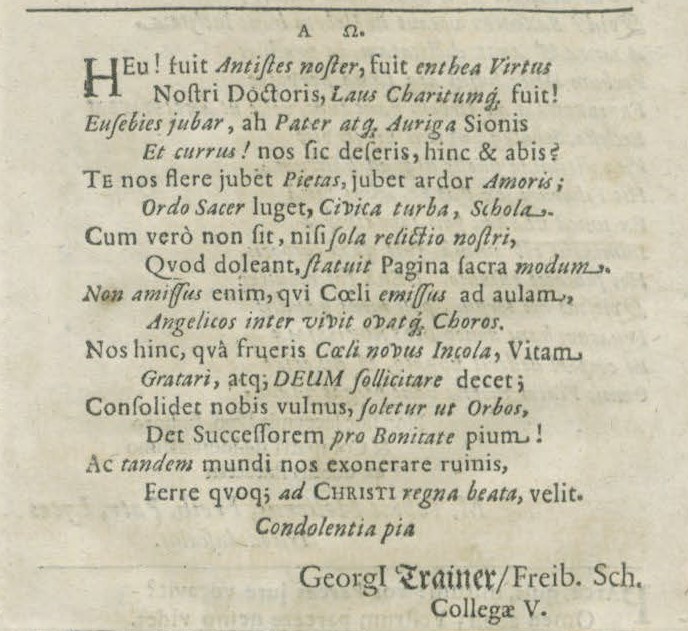
In 1655 Nicolaus Grefius (whose wife was a Horn); Johannes Caspar Horn; Johannes Lindener; Augustus Schönlebe; Samuel Seyfried; and Georg Trainer; were among those who contributed to Discidium per obitum vere-beatum Foeminae pientissimae Coniugis occulissime Barbarae Waltheriae, sine voto quidem, sed non sine fato factum Viro
Epithalamion in honorem … : [Hochzeitsgedicht auf Georg Herder und Ursula Trainer vom Okt. 1581]
For families from which the wives of above Trainer family are descended please visit the page titled: ‘THE ANTECEDENT FAMILIES OF THE TRAINER FAMILY‘.
